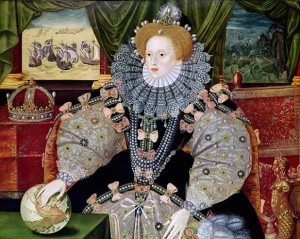by Anna Whitelock
In The Queen’s Bed: An Intimate History of Elizabeth’s Court, the historian Anna Whitelock offers a revealing look at the Elizabethan court and the politics of intimacy, dramatically reconstructing the Queen’s quarters and the women who patrolled them. With expert research and lively prose, Whitelock weaves a fascinating tale of sex, gossip, conspiracy, and intrigue, brought to life amid the colors, textures, and routines of the court: the untold story of Elizabeth I laid bare.
As Queen, Elizabeth would have a number of beds, sumptuously furnished in bright colors and luxurious fabrics, all ostentatiously decorated and individually designed, each fit for a queen. At Richmond Palace, Elizabeth might sleep in an elaborate boat-shaped bed with curtains of ‘sea water green’ and quilted with light-brown tinsel. At Whitehall her bed was made from an intricate blend of different- colored woods and hung with Indian-painted silk. Her best bed, which was taken with her when the court moved from place to place, had a carved wooden frame which was elaborately painted and gilded, a valance of silver and velvet, tapestry curtains trimmed with precious buttons and gold and silver lace, and a crimson satin headboard topped with ostrich feathers.
The Queen’s Two Bodies
In her Bedchamber, Elizabeth could de-robe, take off her make-up and withdraw from the hustle-bustle of the court. Here she was waited upon by her ladies who had the most intimate access to the Queen, attending on her as she dressed, ate, bathed, toileted and slept. Elizabeth was never alone and in or adjacent to her bed she also had a sleeping companion – a trusted bedfellow – with whom she might gossip, share dreams and night- mares, and seek counsel. We know Elizabeth was both an insomniac and scared of the dark. All her worries were magnified in the darkness of her Bedchamber at night. It was here that she might have second thoughts about decisions made in the light of day, be haunted by fears of her enemies and plagued by vivid nightmares. Sharing a bed with a sleeping companion of the same sex was a common practice at the time, providing warmth, comfort and security; but being the Queen of England’s bedfellow was a position of the greatest trust, bringing close and intimate access to Elizabeth.

Elizabeth I of England, the Armada Portrait. Painted to commemorate victory over the Spanish Fleet in 1588. Image is in the public domain via History Today.
The Queen’s Bedchamber was at once a private and public space. The Queen’s body was more than its fleshly parts; her body natural represented the body politic, the very state itself. The health and sanctity of Elizabeth’s body determined the strength and stability of the realm. Illness, sexual immorality and infertility were political concerns and it was her Ladies of the Bedchamber who were the guardians of the truth as to the Queen’s and thus the nation’s well-being.
An unmarried queen heightened fears. Women were expected to marry and Elizabeth’s decision to remain unwed ran counter to society’s expectations. It was generally believed that women were inferior to men and so subject to them by divine law. Women who ignored religious precepts and did not submit to male authority were potentially a source of disorder and sexual license. Medical discourse regarded women’s bodies as being in a constant state of flux and so possessing dangerously unstable qualities. Such medical axioms were influenced by theology, with the belief that Eve’s moral and intellectual weakness had been the primary cause of the Fall of Man and succeeding generations of women were similarly flawed.
Whilst for her male predecessors sexual potency might be a sign of political power, the corruption or weakness of Elizabeth’s body would undermine the body politic. Women were to preserve their honor not only through chastity, but also by maintaining a reputation for chaste behavior. For a woman to be thought unchaste, even falsely, would jeopardize her social standing. Moreover, Elizabeth was the daughter of Anne Boleyn, ‘the King’s whore’, and so the living symbol of the break with Rome. For Philip II of Spain, the Guise family in France, and the Pope, Elizabeth was illegitimate by birth and by religion. For them Mary Stuart, Queen of Scots, was the rightful queen. Mary was the grand- daughter of Henry VIII’s sister Margaret, who had married James V of Scotland and was daughter of Mary of Guise. The Guise was one of the most powerful, ambitious and fervently Catholic families in France. In April, just six months before Elizabeth’s accession, this Franco- Scottish alliance was cemented by the marriage of sixteen-year-old Mary Stuart and François of Valois, the Dauphin of France. From the day Elizabeth became Queen, Mary Stuart claimed the English throne as her own. The stakes could not have been higher; the Queen’s body was at the center of a drama that encompassed the entirety of Europe. In the war of faith which divided Europe, Elizabeth’s body, with her bed as its stage, was the focal point of the conflict.
Anna Whitelock received her PhD in history from Corpus Christi College, Cambridge, in 2004 with a thesis on the court of Mary I. Her articles and book reviews on various aspects of Tudor history have appeared in many publications, including The Guardian, The Times Literary Supplement, and BBC History. She has taught at Cambridge University and is now a lecturer in early modern history and the director of public history at Royal Holloway, University of London.
